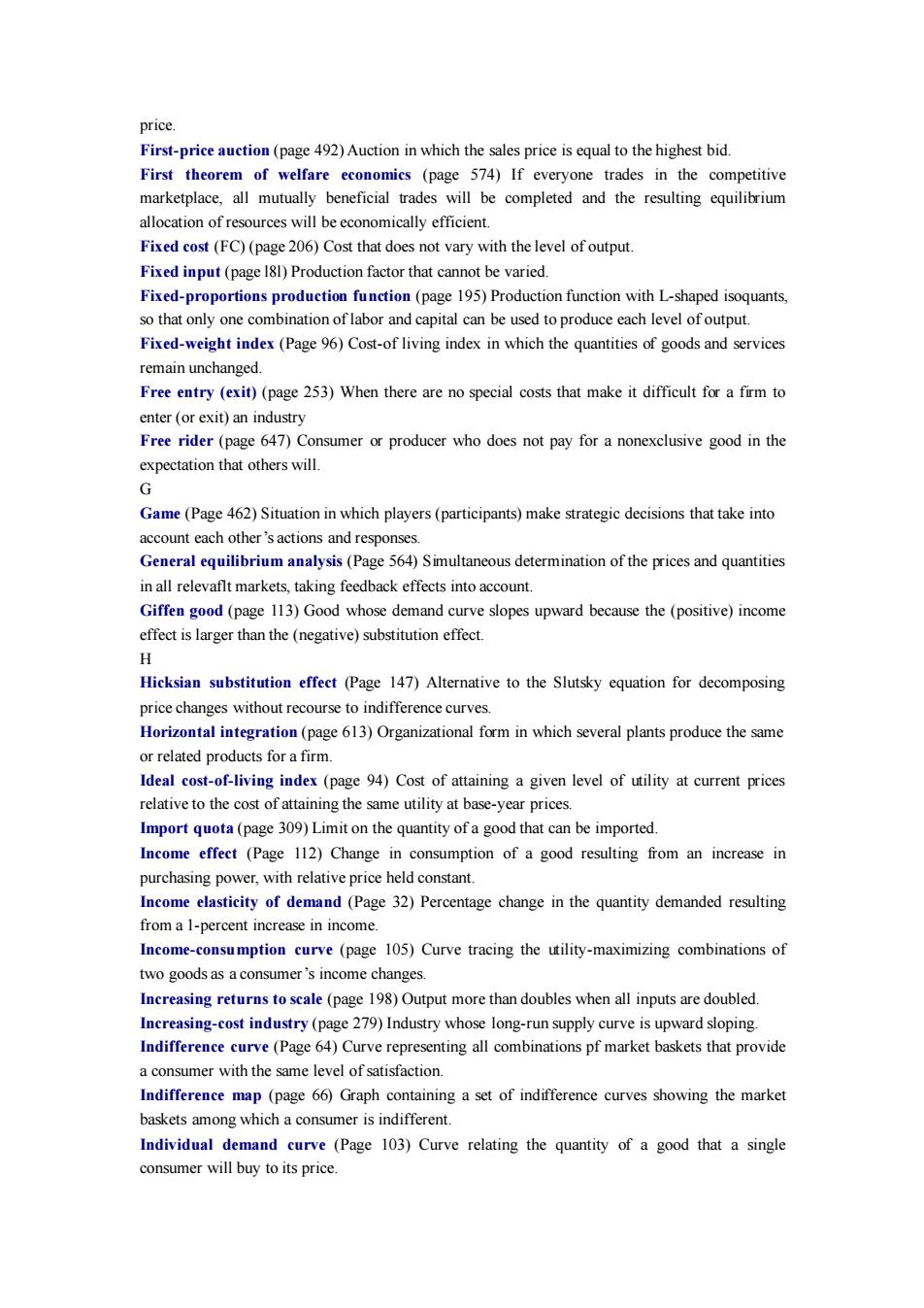正在加载图片...

nrice First-price(page 49)Auction in which the saes price highest bid First theorem of welfare ccono (page 574)If everyone trades in the competitive marketplace,all mutually beneficial trades will be completed and the resulting equilibrium allocation of resources will be economically efficient. Fixed eost(FC)(page 206)Cost that does not vary with the level of output. Fixed input(page )Production factor that be varied. Fixed-propiopro(page 195)Production ith so that only one combination of labor and capital can be used to produce each level of output Fixed-weight index (Page 96)Cost-of living index in which the quantities of goods and services remain unchanged. Free entry (exit)(page 253)When there are no special costs that make it difficult for a firm to Free rider(page 647)C nsumer r producer who does not pay for a nonexclusive good in the expectation that others will. G Game (Page 462)Situation in which plavers (participants)make strategic decisions that take into alysis (Page 564)Simultaneous determination of the prices and quantities in all relevaflt markets,taking feedback effects into account Giffen good (page 113)Good whose demand curve slopes upward because the (positive)income effect is larger than the(negative)substitution effect. Hicksian substitution effect(Page 147)Alternative to the Slutsky equation for decomposing price changes without recourse to indifference curves Horizontal integration (page 613)Organizational form in which several plants produce the same or related products for a firm. Ideal cost-of-living index(page 94)Cost of attaining a given level of utility at current prices relative to the cost of attainin esame utility at base (page 309)Limit on the quantity of a good that can be imported Income effeet (Page 112)Change in consumption of a good resulting from an increase in ourchasing power.with relative price held constant Income elasticity of demand(Page 32)Percentage change in the quantity demanded resulting from a l-percent increase in income Income-consumption curve(page 105)Curve tracing the uility-maximizing combinations of two goods as aconsumer's income changes. Inereasing returns to scale (page 198)Output more than doubles when all inputs are doubled. Increasing-cost industry (page 279)Industry whose long-run supply curve is upward sloping. Indifference curve(Page 64)Curve representing all combinations pf market baskets that provide sumer with the same level of satisfaction ndiffere map(page6)Graph containing as of indifference curves showing the market baskets among which a consumer is indifferent. Individual demand curve (Page 103)Curve relating the quantity of a good that a single consumer will buy to its price. price. First-price auction (page 492) Auction in which the sales price is equal to the highest bid. First theorem of welfare economics (page 574) If everyone trades in the competitive marketplace, all mutually beneficial trades will be completed and the resulting equilibrium allocation of resources will be economically efficient. Fixed cost (FC) (page 206) Cost that does not vary with the level of output. Fixed input (page l8l) Production factor that cannot be varied. Fixed-proportions production function (page 195) Production function with L-shaped isoquants, so that only one combination of labor and capital can be used to produce each level of output. Fixed-weight index (Page 96) Cost-of living index in which the quantities of goods and services remain unchanged. Free entry (exit) (page 253) When there are no special costs that make it difficult for a firm to enter (or exit) an industry Free rider (page 647) Consumer or producer who does not pay for a nonexclusive good in the expectation that others will. G Game (Page 462) Situation in which players (participants) make strategic decisions that take into account each other’s actions and responses. General equilibrium analysis (Page 564) Simultaneous determination of the prices and quantities in all relevaflt markets, taking feedback effects into account. Giffen good (page 113) Good whose demand curve slopes upward because the (positive) income effect is larger than the (negative) substitution effect. H Hicksian substitution effect (Page 147) Alternative to the Slutsky equation for decomposing price changes without recourse to indifference curves. Horizontal integration (page 613) Organizational form in which several plants produce the same or related products for a firm. Ideal cost-of-living index (page 94) Cost of attaining a given level of utility at current prices relative to the cost of attaining the same utility at base-year prices. Import quota (page 309) Limit on the quantity of a good that can be imported. Income effect (Page 112) Change in consumption of a good resulting from an increase in purchasing power, with relative price held constant. Income elasticity of demand (Page 32) Percentage change in the quantity demanded resulting from a 1-percent increase in income. Income-consumption curve (page 105) Curve tracing the utility-maximizing combinations of two goods as a consumer’s income changes. Increasing returns to scale (page 198) Output more than doubles when all inputs are doubled. Increasing-cost industry (page 279) Industry whose long-run supply curve is upward sloping. Indifference curve (Page 64) Curve representing all combinations pf market baskets that provide a consumer with the same level of satisfaction. Indifference map (page 66) Graph containing a set of indifference curves showing the market baskets among which a consumer is indifferent. Individual demand curve (Page 103) Curve relating the quantity of a good that a single consumer will buy to its price